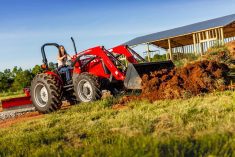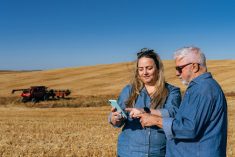In south central Manitoba, a couple we’ll call Harry and Marge, 81 and 73, are tackling the problem of transferring their 1,760 acre farm, mostly pasture, and their 120 cattle, to their children who we’ll call Bob, 46, and Cathy, 42.
Harry and Marge know they have to give up control sooner or later, given Harry’s age. Their children have been farm employees for three decades and know the business well, but there is a feeling in the family that they are not ready to manage.
“The challenge for the parents, especially for Harry as the chief decision maker and sole shareholder of the company, is to transfer the corporation to the children without compromising the viability of the business,” says Don Forbes, head of Don Forbes Associates Inc./ Armstrong & Quaile Inc. in Carberry, Man. Harry and Marge, for whom he is an advisor, have to transfer ownership and control, he says. The necessity is undeniable. But how to do it is the problem.
Read Also

Gentle treatments for pain in the neck
Heading toward year-end, people unknowingly tense up against the cold and busyness, causing neck pain that can often be treated with appropriate support and gentle mobility, athletic therapist Kathlyn Hossack says.
Don and his son, Erik Forbes, point out that the retained earnings in the farming corporation are taxable when the corporation is sold or wound up. If the farm land itself is sold, gains in value will also be taxable. The goal is to transfer the farm and its land to the two children in equal shares while minimizing potential capital gains taxes, Don notes.
The Canada Revenue Agency allows situations for business-based capital gains to be exempt from capital gains tax. Shares of a small incorporated business can be sold to a qualified buyer. The price difference between the book value of the shares and their fair market value can be exempted from capital gains tax up to a value of $800,000 per shareholder in the sale. The rule also applies to the sale of personally owned farm land. Each piece of farm land being sold must be personally owned, with each owner claiming farm income on his or her income tax return.
Bob has $800,000 of capital gains exemption available which he can split between the farm land and farming corporation shares, as both are in his name. Cathy can be made eligible for an additional $800,000 of capital gains exemption if the farm business is restructured, Don Forbes says.
All of the gain in the farm land and a portion of the value of the corporation could be sheltered. But this depends on how the business is valued. If the corporation has a value over $670,000, Cathy could be made eligible to use her $800,000 capital gains exemption. That would create a $1.6 million combined capital gains exemption. If the land is transferred to the children to create a $430,000 capital gain and the $800,000 exemption is applied, then a $370,000 residue of exemption would be left to claim, Erik Forbes explains.
- More with Andrew Allentuck: Guarding wealth: Buying risk, paying for liquidity
There is no doubt that Harry is qualified to use the Farm Land Capital Gains exemption, though Cathy’s eligibility for it could be challenged by tax authorities. Though the land is held jointly, the Canada Revenue Agency prefers to see a joint farming profit and loss statement on annual personal tax returns for the spouse to qualify for the credit, Don Forbes notes.
“To make the exemption strategy work, Harry and Marge will have to work with their accountant to structure farming profit and loss statements and tax returns for the next two years to include Cathy’s name,” Mr. Forbes says. “That should help her qualify for the farm land capital gains tax exemption when the transfer takes place. Then in 2016, when two years of farming profit and loss statements have been filed with Cathy’s name included, the children can purchase the farm and its land.”
Harry should sell his shares to Bob and Cathy as an even split of value. If the fair market value is $500,000 with a book value of $300,000, there will be $200,000 of recaptured depreciation. That is classified as taxable income. If company shares are sold to a qualified small business owner, then the capital gains exemption for corporate shares will be triggered, saving about $100,000 in tax. “The couple will have to work closely with their accountant to ensure that they comply with the rules,” Don Forbes says.
To make the recommended transfer work and comply with CRA rules, the purchase agreement for the sale of shares could be a demand note with a take back feature. Thus if one of the children gets divorced, the transfer value, if embedded in a mortgage or other debt instrument, would be protected. They also need a shareholder agreement with all shareholders. This agreement should describe buyout terms, management control, and the demand note take back.
The parents should update their wills to reflect the shareholder agreement. And there has to be management contract with the children, which describes their jobs, level of responsibility, wages and benefits including sick and holiday time and any bonus arrangements. Finally, the purchase agreement should have a plan for skills transition training, especially management and book keeping duties. If the home farm is left to the children in acreage of unequal value, then there could be a gift plan to equalize the dollar value of the farm transfer.
There is also a matter of off-farm investments. Harry and Marge have $660,000 of non-RRSP money in a major online brokerage account and RRSPs of financial services and energy stocks that produce $20,000 a year in Canadian-source dividends. They should consolidate all their non-RRSP investment accounts into a joint account with right of survivorship so that, upon the death of one spouse, there would be no deemed disposition in the transfer to the surviving partner. That would avoid capital gains tax, Erik Forbes adds.
There is clearly a lot of accounting and investing work to do. Harry and Marge could hire an investment manager to handle their off-farm portfolio. They should check on fees, which are usually based on assets under management. For portfolio of their size, they might pay one to 1.5 per cent of assets under management. Fees paid for management of assets other than those exempt from current tax, such as RRSPs, would be deductible from taxable income, Don Forbes adds.
Finally, Harry and Marge should ensure that their Tax-Free Savings Accounts are maximized each year to shelter as much investment growth. The present contribution limit is $31,000 and it will grow by $5,500 each time January 1 comes around, Erik Forbes says. In the decade following the asset transfers, Harry and Marge will have rising incomes based largely on off-farm investments and post-tax incomes rising from $75,000 in 2014 to $100,000 when Harry is 87 and Marge is 79 to $106,000 when he is 90 and Marge is 82. “It’s win-win for everybody,” Don Forbes says.
With planning focused on the farm transfer and tax minimization, the legacy that Harry and marge have built will be protected. “These plans, as I have outlined them, will protect what the children get as they assume management and ownership of the farm. The plan has an equality of what each child gets, but the children will be free to adjust their duties and ownership after the plan goes into effect,” Don Forbes says.















